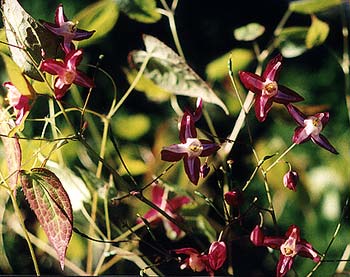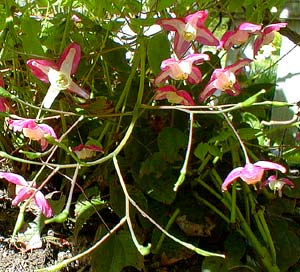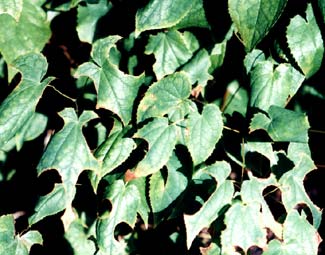 Red Epimedium
Red Epimedium
"If you see a dark red flower beneath a bush,
And lying secretly, you would know
It was the kiss we drew on each other's lips."
-Humayun Azad Zindabad
(1947-2004)
(1947-2004)
We have three epimediums around our gardens, including Lilafee Epimedium (E. grandiflorum 'Lilafee,' Yellow Epimedium (E. x versicolor 'Sulphureum,') & the subject of the present page, Red Epimedium (E. alpinum 'Rubrum').
Red Epimedium has lovely spiked blooms as shown in the photos on this page, the first photo taken in early May (2002), the second photo in late April (2003). When it is at the height of bloom, its leaves are not yet very big, leaving the small flowers to show quite boldly in deep magenta. The blooms are strongest in April & May, but it not rare that it still puts up an occasional bloom later in the year, though once the fabulous leaves are grown thick in mid-May through Autumn, later blooms will not seem as significant.
 Though the Red was bred for stronger evergreen qualities I think our Yellow Epimedium lasts a bit better through winter, so that mainly the winter qualities for the Red amount to an improvement over vanishing altogether. Both varieties are more apt to be evergreen further south. The Red may sometimes get a little taller than the Yellow & the leaves aren't quite so large. It is otherwise extremely similar in the beauty of the leaves.
Though the Red was bred for stronger evergreen qualities I think our Yellow Epimedium lasts a bit better through winter, so that mainly the winter qualities for the Red amount to an improvement over vanishing altogether. Both varieties are more apt to be evergreen further south. The Red may sometimes get a little taller than the Yellow & the leaves aren't quite so large. It is otherwise extremely similar in the beauty of the leaves.The Red flowering epimedium is planted underneath a big 'Loder's White' Rhododendron. In 2002, for whatever peculiar reason, the leafcutter bees took a particular liking to this plant. Usually the leafcutter bees cut out so few circles from a wide enough variety of plants that their mischief isn't really noticeable on any one thing. The year before, they did take an extra liking to the Akebia Vines but even so you'd have to look carefully to see where they did the cutting.
The third photo shows the damage done by the bees. I found it so fascinating that I made no attempt to interfer with them, though it was a relief when they quit.
I watched the activities of the leafcutters with considerable interest. A bee would stand on a leaf & cut around itself in a circle or half-circle at the edge. When the circle is almost done, it would begin to flap its wings like crazy so that it wouldn't plummet to the ground when the last cut was done. They're great fun to watch at work! They fly off with their prize to line each of their solitary nests, which are usually underground.
 Having these bees means everything gets pollinated properly, & once their nest is completed they stop cutting, so there is no need to worry about them permanently harming plants, or doing this endlessly. Mason bees also do a little bit of leafcutting, but not as religiously nor do they perform so big a cut.
Having these bees means everything gets pollinated properly, & once their nest is completed they stop cutting, so there is no need to worry about them permanently harming plants, or doing this endlessly. Mason bees also do a little bit of leafcutting, but not as religiously nor do they perform so big a cut.Still, when there are several solitary leafcutters in a small area & they're all focusing their attention on just two plants -- during 2002, they preferred the Red epimedium & a nearby meadow rue -- their doings can become a bit too obvious. I don't mind, & still regard the bees as completely beneficial. But the final picture on this page shows the epimedium leaves this past August, by which time they were considerably cut up.
I'm sure some people would want to hurt the bees for doing this, but in our woodland garden setting, a healthful organic balance means the garden serves nature as much as it serves our human needs. If this is the worse that can happen, then everything is good.